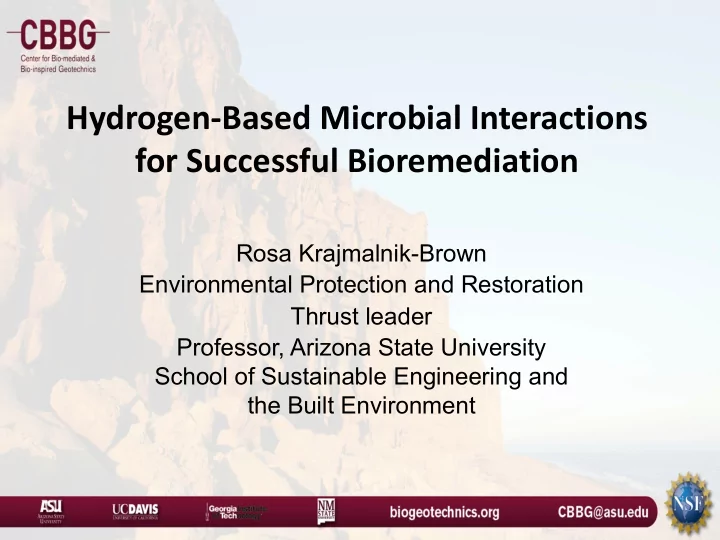

Hydrogen-Based Microbial Interactions for Successful Bioremediation Rosa Krajmalnik-Brown Environmental Protection and Restoration Thrust leader Professor, Arizona State University School of Sustainable Engineering and the Built Environment
Chloroteh Ch ehen enes es in in Grou Gr oundwater r 1. The problem 2. Bioinspired and Biomediated solution 3. Some contributions from my lab towards enhancing Bioinspired solution 4. New H 2 based insight www.biogeotechnics.org
Ch Chlor orot otehenes s in in Gr Groundw undwater r U.S. Superfund Sites: • More than 1000 sites • 60% polluted with PCE/TCE 3 Image: https://www.epa.gov/enforcement/map-superfund-enforcement-cleanup-work
Bioinspired solution? Halogenated Organics Microbial Dehalogenation Biogenic Geogenic Anthropogenic Halogenation Cl - Br - F - I - Organic Compounds
Reductive dechlorination • Bioremediation of PCE and TCE to ethene occurs under anaerobic conditions via reductive dechlorination with H 2 as electron donor. • Dehalococcoides mccartyi are the only microbes capable of detoxification of chlorinated ethenes to ethene.
Development of fast dechlorinating cultures Development and grow CE to ethene Dehalococcoides cultures Sediment Anaerobic medium & nutrients
7 Delgado et al., Plos One , 2014, 9
mmol L −1 Time (days) 8 Delgado et al., Plos One , 2014, 9
Bioagmentation on the same soil? Cuzdrioara bioaugmentation Carolina bioaugmentation 9 Delgado et al., Plos One , 2014, 9
FTFHS Arc mcrA Dhc Geo 10
Hydrogen ”demand” in the subsurface X Objectives 1. Track H 2 consumption in a variety of soils and sediments 2. Which electron accepting processes dominate under a regime of excess H 2 . 11 Image: https://clu-in.org/
15 soils and sediments NO 3 - 2- Organic C SO 4 Fe 3+ COD Inorganic C 100 days 12
Lessons learned • Robust Enrichment process, scale up and application at the field scale. • Inorganic carbon metabolism (acetogenesis and methanogenesis) dominated in most soils. • Organic carbon and Humics can consume H 2 and perhaps release it later for processes like reductive dechlorination.
Thank you!
Questions? Dr.rosy@asu.edu krajmalnik.environmentalbiotechnology.org Like us on Facebook Dr.Rosy’s Lab-The lab of Dr Rosa krajmalnik-Brown.
Recommend
More recommend